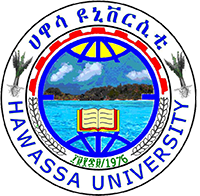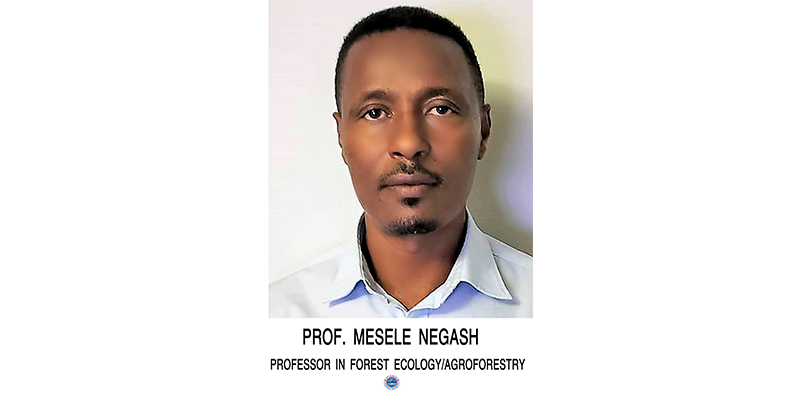- Peer-reviewed and reputable articles/book chapter
Published articles
2023
- Tariku Olana Jawo, Nikola Teutscherová, Mesele Negash, Kefyalew Sahle &
Bohdan Lojka (2023) Smallholder coffee-based farmers’ perception and their adaptation strategies
of climate change and variability in South-Eastern Ethiopia, International Journal of Sustainable
Development & World Ecology, DOI: 10.1080/13504509.2023.2167241
2022
- Habitamu Taddese, Mesele Negash, Tariku Geda, Gebiaw T. Ayele, 2022 Carbon Sequestration Potentials of Different Land Uses in Wondo Genet Sub-Catchment, Southern Ethiopia. Land 2022, 11, 2252. https://doi.org/10.3390/land11122252
- Eyob Tadesse, Mesele Negash (2022) Impacts of indigenous agroforestry practices and elevation gradient on ecosystem carbon stocks in smallholdings’ farming system in South‑Central Ethiopia. Agroforest Systems https://doi.org/10.1007/s10457-022-00781-4
- Mesele Negash, Janne Kaseva, Helena Kahiluoto (2022) Determinants of carbon and nitrogen sequestration in multistrata agroforestry. Science of the Total Environment 851:158185. http://dx.doi.org/10.1016/j.scitotenv.2022.158185
- Heiru Sebrala, Amsalu Abich, Mesele Negash, Zerihun Asrat, Bohdan Lojka (2022) Tree allometric equations for estimating biomass and volume of Ethiopian forests and establishing a database: Review. Trees, Forests and People.
- Amsalu Abich, Mesele Negash, Asmamaw Alemu, Temesgen Gashaw 2022. Aboveground Biomass Models in the Combretum-Terminalia Woodlands of Ethiopia: Testing Species and Site Variation Effects. Land 2022, 11, 811. https://doi.org/10.3390/land11060811
- Hafte Mebrahten Tesfay, Mesele Negash, Douglas L. Godbold, Herbert Hager, 2022. Assessing Carbon Pools of Three Indigenous Agroforestry Systems in the Southeastern Rift-Valley Landscapes, Ethiopia. Sustainability 2022, 14, x. https://doi.org/10.3390/xxxxx
- Mesele Negash, Janne Kaseva, Helena Kahiluoto, 2022. Perennial monocropping of khat decreased soil carbon and nitrogen relative to multistrata agroforestry and natural forest in southeastern Ethiopia. Regional Environmental Change 22:38. https://doi.org/10.1007/s10113-022-01905-3
- Bezashwork Melaku Asmare, Mesele Negash Tesemma, Shimelis Nigatu Gebremariam, Tefera Belay Endalamaw. 2022. Comparison of calorific values and physico-chemical properties among three age groups and height positions of Acacia decurrens (Willd). Biomass Conversion and Biorefinery doi: 10.1007/s13399-021-02242-x
- Abel Feyisa, Mesele Negash and Yoseph Melka 2022. Research Article Urban green infrastructure affects woody plant diversity and carbon stock in Hawassa city in Ethiopia. Arboricultural Journal, 2021 https://doi.org/10.1080/03071375.2021.2014696
2021
- Eyob Tadesse. Mesele Negash. Zebene Asfaw, 2021. Impacts of traditional agroforestry practices, altitudinal gradients and households’ wealth status on perennial plants species composition, diversity, and structure in south-central Ethiopia. Agroforest Systems doi.org/10.1007/s10457-021-00659-x
- Mesele Negash, Mike Starr, 2021. Litter decomposition of six tree species on indigenous agroforestry farms in south-eastern Ethiopia in relation to litterfall carbon inputs and modelled soil respiration. Agroforestry System 95: 95:755–766https://doi.org/10.1007/s10457-021-00630-w
- Abayneh Legesse, Mesele Negash (2021). Species diversity, composition, structure and management in agroforestry systems: the case of Kachabira district, Southern Ethiopia. Heliyon 7: e06477. https://doi.org/10.1016/j.heliyon.2021.e06477
2020
- Gebru Eyasu, Motuma Tolera, Mesele Negash (2020) Woody species composition, structure, and diversity of home garden agroforestry systems in southern Tigray, Northern Ethiopia. Heliyon 6, e05500. doi.org/10.1016/j.heliyon.2020.e05500
- Desalegn Getnet, Mesele Negash (2020) Allometric equations for estimating aboveground biomass of khat (Catha edulis)-stimulate grown in agroforestry of Raya Valley, Northern Ethiopia. Heliyon 6: e05839. doi.org/10.1016/j.heliyon.2020.e05839
- Zerihun Belay, Mesele Negash, Janne Kaseva, Mauritz Vestberg, Helena, Kahiluoto. 2020. Native forests but not agroforestry systems preserve arbuscular mycorrhizal fungal species richness in southern Ethiopia. Mycorrhiza. doi.org/10.1007/s00572-020-00984-6
- Zerihun Asrat, Tron Eid, Terje Gobakken, Mesele Negash, 2020. Modelling and quantifying tree biometric properties of Dry Afromontane forests of South-central Ethiopia. Trees doi.org/10.1007/s00468-020-02012-8
- Zerihun Asrat, Tron Eid, Terje Gobakken, Mesele Negash, 2020. Aboveground tree biomass prediction options for the Dry Afromontane forests in South-central Ethiopia. Forest Ecology and Management 473:118335. doi.org/10.1016/j.foreco.2020.118335
- Mulugeta Betemariyam, Mesele Negash, Adefires Worku, 2020. Comparative Analysis of Carbon Stocks in Home Garden and Adjacent Coffee Based Agroforestry Systems in Ethiopia. Small-scale Forestry https://doi.org/10.1007/s11842-020-09439-4
- Befekadu Mewded, Mesele Negash, Tesfaye Awas 2020. Woody species composition, structure and environmental determinants in a moist evergreen Afromontane forest, southern Ethiopia. 2019. Journal of Forestry Research 31(4), 1173–1186. doi.org/10.1007/s11676-019-00894-0
- Emiru Birhane, Said Ahmed, Mengsteab Hailemariam, Mesele Negash, Meley Mekonen Rannestad, Lindsey Norgrove. 2020. Carbon stock and woody species diversity in homegarden agroforestry along an elevation gradient in southern Ethiopia. Agroforest Systems 94, 1099–1110. doi.org/10.1007/s10457-019-00475-4
2019
- Ashenafi Manaye, Mesele Negash, Mehari Alebachew. 2019. Effect of degraded land rehabilitation on carbon stocks and biodiversity in semi-arid region of Northern Ethiopia. Forest Science and Technology 15:2, 70–79. doi.org/10.1080/21580103.2019.1592787
2018
- Kim, Dong-Gill, Chung, Suh-Yong, Melka, Yoseph, Negash, Mesele, Tolera, Motuma, Yimer, Fantaw, Belay, Teferra, Bekele, Tsegaye. 2018. Calling for Collaboration to Cope with Climate Change in Ethiopia: Focus on Forestry. Journal of Climate Change Research 9, 303-312
- Gadisa Demiea, Mesele Negash, Tesfaye Awas. 2018. Ethnobotanical study of medicinal plants used by indigenous people in and around Dirre Sheikh Hussein heritage site of South-eastern Ethiopia. Journal of Ethnopharmacology 220, 87–93. doi.org/10.1016/j.jep.2018.03.033
- Musse Tesfaye, Mesele Negash. 2018. Combretum-Terminalia vegetation accumulate more carbon stocks in the soil than the biomass along the elevation ranges of dryland ecosystem in Southern Ethiopia. Journal of Arid Environments 155: 59–64. doi.org/10.1016/j.jaridenv.2018.02.004
14.. Kebede Wolka, Geert Sterk, Birhanu Biazin, Mesele Negash. 2018. Benefits, limitations and sustainability of soil and water conservation structures in Omo-Gibe basin, Southwest Ethiopia. Land Use Policy 73: 1–10. doi.org/10.1016/j.landusepol.2018.01.025
- 13. Haji Kedir, Mesele Negash, Fantaw Yimer, Mulugeta Limenih. 2018. Contribution of participatory forest management towards conservation and rehabilitation of dry Afromontane forests and its implications for carbon management in the tropical Southeastern Highlands of Ethiopia. Journal of Sustainable Forestry. 37 (4), 357–374. doi.org/10.1080/10549811.2017.1414614
2015
- Mesele Negash, Markku Kanninen. 2015. Modeling biomass and soil carbon pools change of indigenous agroforestry system using CO2FIX approach. Agriculture, Ecosystems and Environment 203:147-155. doi.org/10.1016/j.agee.2015.02.004
- Mesele Negash, Mike Starr. 2015. Biomass and soil carbon stocks of indigenous agroforestry systems on the south-eastern Rift Valley escarpment, Ethiopia. Plant and Soil 393:95–107. doi 10.1007/s11104-015-2469-6
- Eshetu Yirdaw, Mike Starr, Mesele Negash, Fantaw Yimer. 2015. Influence of topographic aspect on floristic diversity, structure and treeline of Afromontane cloud forests in the Bale Mountains, Ethiopia. Journal of Forestry Research 26(4):919–931. doi 10.1007/s11676-015-0155-4.
2014
- Kebede Wolka, Mesele Negash. 2014. Farmers’ adoption of soil and water conservation technology: a case study of the Bokole and Toni sub-watersheds, southern Ethiopia. Journal of science & Development 2(1) 35-48.
- Mesele Negash, Girma Kelboro, 2014. Effects of socioeconomic status and food consumption pattern on household energy uses: Implications of forest resources degradation around Wondo Genet Catchments, south-central Ethiopia. East African Social Science Research Review (EASSRR) 30(1): 27-46. DOI: 10.1353/eas.2014.0001
2013
- Mesele Negash, Mike Starr, Markku Kanninen, Leakemaraiam Berhe. 2013. Allometric equations for aboveground biomass of Coffea arabica L. grown in indigenous agroforestry systems in the Rift Valley escarpment of southern-eastern Ethiopia. Agroforestry Systems 87:953–966. doi 10.1007/s10457-013-9611-3.
- Mesele Negash, Mike Starr, Markku Kanninen. 2013. Allometric equations for biomass estimation of Enset (Ensete ventricosum) grown in indigenous agroforestry systems in the Rift Valley escarpment of southern-eastern Ethiopia. Agroforestry Systems 87:571–581. doi 10.1007/s10457-012-9577-6.
- Mesele Negash, Mike Starr. 2013. Litterfall production and associated carbon and nitrogen fluxes of seven woody species grown in indigenous agroforestry systems in the Rift Valley escarpment of Ethiopia. Nutrient cycling in Agroecosystem 97:29–41. doi 10.1007/s10705-013-9590-9
2012
- Mesele Negash, Eshetu Yirdaw, Olavi Luukkanen. 2012. Potential of indigenous multistrata agroforests for maintaining native floristic diversity in the south-eastern Rift Valley escarpment, Ethiopia. Agroforestry systems 85:9–28. doi 10.1007/s10457-011-9408-1
2008
- Negash Mesele, Negussie Achalu. 2008. History of indigenous agro-forestry in Gedeo, Ethiopia based on local community interviews: Vegetation diversity and structure in these land use systems. Ethiopian Journal of Natural Resources 10 (1): 31-52.
2007
- Mesele Negash. 2007. Tree management and livelihoods in Gedeo’sagroforests, Ethiopia. Forest, Trees and Livelihoods 170(2):157-168.
2005
- Mesele Negash, Abdu Abdulkadir, Hagberg S. 2005. Farmers' Eucalyptus planting practices in Enset-Coffee based Agroforestry system of Sidama, Ethiopia. Ethiopian Natural Resource Journal 7(2):239-251
Book/proceedings
- Mesele Negash 2022. Oral presnetaion on “Perennial monocropping of khat decreased soil carbon and nitrogen relative to multistrata agroforestry and natural forest in southeastern Ethiopia.” Tropentag 2022 hybrid conference held on 14-16 Sepetmber 2022, The Czech Rebulic, Prague.
- Mesele Negash, 2018. Overview of Current State of Knowledge for Thickets, Bushes and Shrubs in Eastern Africa. Presented at a national workshop on the theme Combating desertification, sustainable natural resources management and landscape restoration under changing climate in arid and semi-arid areas of Ethiopia. Organized by The Ethiopian Environment and Forest Research Institute (EEFRI) in collaboration with Action Against Desertification Project of FAO Ethiopia. 14- 15 August, 2018. Adama, Ethiopia
- Eshetu Yirdaw, Mulualem Tigabu, Mulugeta Lemenih, Mesele Negash, Demel Teketay. 2014. Rehabilitation of Degraded Forest and Woodland Ecosystems in Ethiopia for Sustenance of Livelihoods and Ecosystem Services (Book chapter). In: Pia Katila, Glenn Galloway, Will de Jong, Pablo Pacheco, Gerardo Mery (eds.) Forest under pressure – local responses to global issues. IUFRO World Series Volume 32. Vienna. pp. 299-313.
- Mesele Negash, 2018. Overview of Current State of Knowledge for Thickets, Bushes and Shrubs in Eastern Africa. Presented at a national workshop on the theme Combating desertification, sustainable natural resources management and landscape restoration under changing climate in arid and semi-arid areas of Ethiopia. Organized by The Ethiopian Environment and Forest Research Institute (EEFRI) in collaboration with Action Against Desertification Project of FAO Ethiopia. 14- 15 August, 2018. Adama, Ethiopia
- Contributing author in a book entitled “Profitable Agroforestry system innovations for eastern Africa: Experience from 10 agroclimatic zones of Ethiopia, India, Kenya, Tanzania and Uganda”. Published in 2007 edited by Azene-BekeleTesemma. World Agroforestry center.
- Sustainable Land Use Form, 2006. Indigenous Agroforestry Practices and their implications on sustainable land use and natural resources management: The case of Wonago Woreda. Research Report No. 1. A commissioned book produced by Negussie Achalu and Mesele Negash.
- Mesele Negash., Mike Starr, Markku Kanninen. 2012. Allometric equations for biomass estimations of Ensete ventricosum grown in indigenous agroforestry systems, southern-eastern Ethiopia: implication for climate change mitigation on agricultural landscapes. Paper presented in “Forests and Trees: Serving the People of Africa and the World”. P.131. Book of Abstracts. IUFRO-FORNESSA Regional Congress & ITTO/AFF Forest Policy Day 25-29 June 2012. Nairobi, Kenya
- Mesele Negash. 2006. Indigenous Agroforestry practices and their implications on Sustainable Land use and Natural Resources management: The case of Wonago District. In: Proceedings Policymakers Workshop on Land Tenure and Land Management. 9 October 2006. Organized by CRDA, SLUF and SOS Sahel Ethiopia. Addis Ababa, Ethiopia. pp. 4-20.
- Mesele Negash. 2007. Indigenous Soil Fertility Management in Gedeo Agroforests, Ethiopia. Paper presented on National Workshop: Making the soil Quality last-Participatory Plant Nutrient Management in Ethiopia. August 6-8, 2007. Wondo Genet College, Ethiopia.
- Mesele Negash. 2007. Whom to blame? The tree or the expert? Newsletter, Volume 4, Issue 1, WGCF-NR. pp.4.
Theses
Mesele Negash. 2013. The indigenous agroforestry systems of the south-eastern Rift Valley Escarpment, Ethiopia: Their biodiversity, carbon stocks, and litterfall. Tropical forestry reports no. 44. Doctoral thesis, University of Helsinki. ISBN 978-952-10-9415-6. ISSN 0786-8170
Mesele Negash. 2002. Socioeconomic aspects of farmers' eucalyptus planting Practices in the Enset-Coffee Based Agroforestry System of Sidama, Ethiopia. The case of Awassa and Shebdino Districts, Ethiopian. MSc in Forestry program Thesis Report No.62.Swedish Agricultural Sciences, SLU, Sweden. pp.85.
References
Mike Starr (PhD), Associate professor in Soil science
Department of Forest Sciences, University of Helsinki,
Latokartanonkaari 7, P.O. Box 27, 00014 Helsinki,Finland
Phone:+358 9 19158121; Fax: +358 9 19158100
e-mail:This email address is being protected from spambots. You need JavaScript enabled to view it.
Helena Kahiluoto, Professor of Sustainability Science
Lappeenranta University of Technology (LUT)
PL 20, FI-53851 Lappeenranta, Finland
Tel +358 40 5118335
E-mail This email address is being protected from spambots. You need JavaScript enabled to view it.
Motuma Tolera (Ph.D.), College Dean
School of Forestry,
Wondo Genet College of Forestry and Natural Resources,
Hawassa University,
P. O. Box 128, Shashemene, Ethiopia.
Tele. +251911797142
E-mail:This email address is being protected from spambots. You need JavaScript enabled to view it.




















